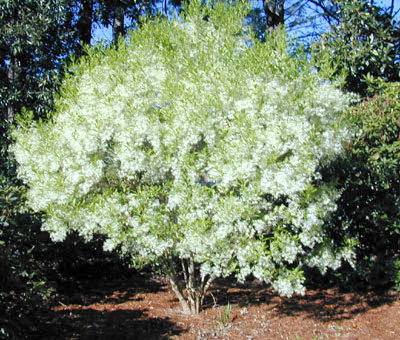Chionanthus virginicus: Fringe Tree

Latin name: Chionanthus virginicus
Common name: Fringetree
Flowers: Showy, creamy white and fragrant16
Fruit or cones: Dark blue in fall16
Height & Width: 12-20’ x 12-20’16
Type: Deciduous16
Wetland indicator category**: FACU17
Habit: Spreading, open crown; variable shape between seedlings; often multistemmed.1
Texture: Medium to coarse16
Growth rate: Slow to moderate16
Light: Sun to partial shade16
Moisture: Prefers moist, well-drained soil16
Soil: Tolerates clay; sand; loam; acidic16
Zones: 3-916
Origin: Southeastern United States16
Features: Panicles of creamy white fragrant flowers are suspended from branches in May and male flowers, more showy, bear dark blue fruit in the fall. A large shrub to small tree it is adaptable and the fruit attracts birds. It is tolerant to air pollution and flowers quickly.16
Siting: Plant in moist, well-drained soil that is in a sunny location. Slight shade is acceptable. It is very well sited near sidewalks and roads due to the roots not being considered a problem.12
Care: Plant the tree in the hole so that the root flare is visible at the soil surface. The hole should be only as deep as the root ball and two to three times as wide as the root ball14, 18. At planting, water the root ball daily with two gallons of water per inch of trunk diameter for two weeks, every other day for two months and then weekly until established15. Modify water recommendations to reflect site drainage and rainfall. Apply 3” of mulch over the planted area. Do not allow mulch to touch the trunk.14, 18
Pests: Leaf spots can be caused by several genera of fungi. Most years, the leaf spots are not a problem and there is no cause for control, but they can cause premature defoliation and spoil fall color display. Powdery mildews of different genera may attack Fringetree. Stem cankers can girdle stems.15
Author: Whitney Blue Fraser, Editor: Alexander Smolka
Sources 1-18 found on Sources page
